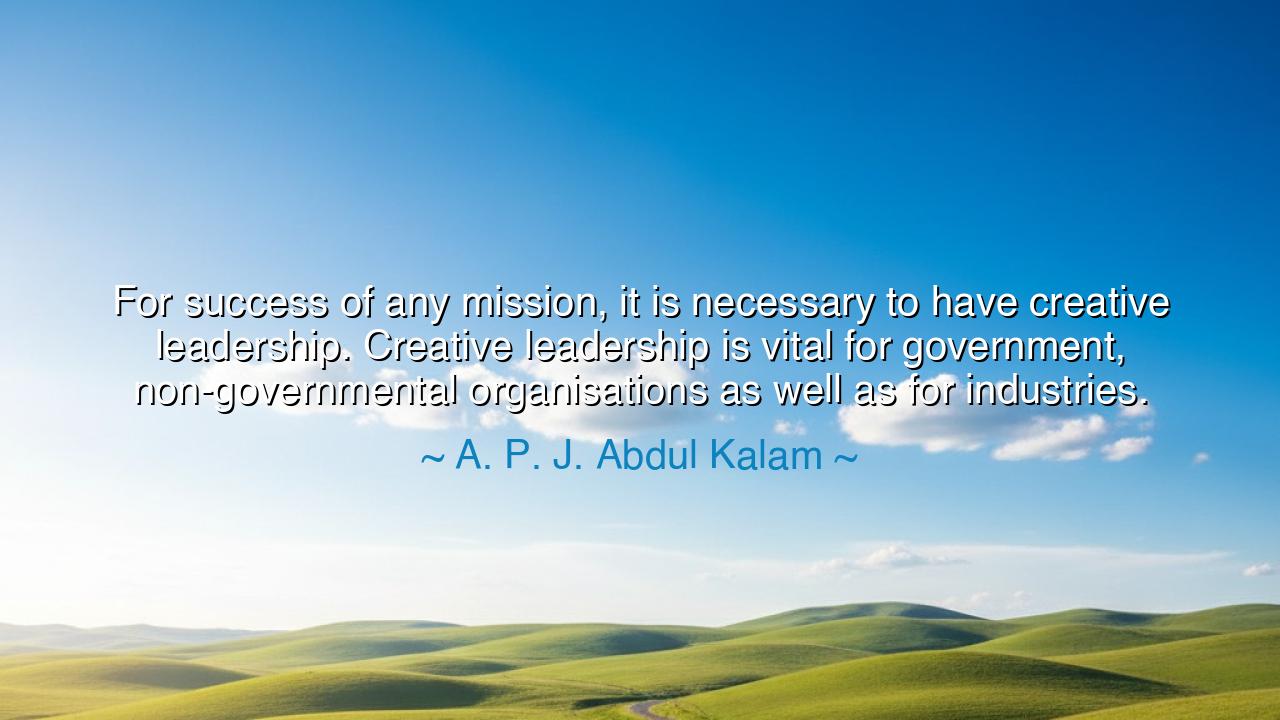
For success of any mission, it is necessary to have creative
For success of any mission, it is necessary to have creative leadership. Creative leadership is vital for government, non-governmental organisations as well as for industries.






The words of A. P. J. Abdul Kalam, the “People’s President” of India and one of the most visionary scientists of the modern age, shine like a beacon to all who aspire to lead: “For success of any mission, it is necessary to have creative leadership. Creative leadership is vital for government, non-governmental organisations as well as for industries.” In this profound declaration, Dr. Kalam touches the eternal truth that leadership is not about command, but about creation — the power to envision what does not yet exist, and the courage to bring it into being. He speaks as a man who built his life upon dreams, who turned imagination into engines, and who saw in every human being the potential to rise beyond the ordinary.
To understand the meaning of this quote, we must first grasp what creative leadership truly is. It is not the authority to direct others, nor the skill to manage systems — it is the ability to inspire vision, to kindle imagination, and to nurture innovation. Where conventional leadership repeats, creative leadership renews. It seeks solutions where others see obstacles, and opportunities where others see limits. Dr. Kalam, who led India’s missile and space programs, understood that progress depends not on power, but on imagination guided by purpose. The true leader, he believed, is a creator — one who ignites minds, uplifts spirits, and transforms adversity into achievement.
The origin of these words comes from the heart of Kalam’s philosophy — one rooted in his life’s journey. Born in humble circumstances in Rameswaram, India, he rose through perseverance and learning to become the architect of his nation’s technological self-reliance. He led the Integrated Guided Missile Development Program, transforming India into a defense power. Later, as President, he sought to inspire the youth to dream beyond boundaries. Through it all, his leadership was never imposed — it was inspired. He believed that a mission succeeds only when every member of a team becomes a visionary in their own right, united not by fear of failure, but by the shared fire of purpose. Thus, “creative leadership” was not a theory to him — it was his lived truth.
History offers many reflections of this principle. Consider Ernest Shackleton, the polar explorer who led his crew through the frozen desolation of Antarctica after their ship, Endurance, was crushed by ice in 1915. Against hopeless odds, Shackleton’s creative leadership — his calm under chaos, his innovative problem-solving, and his ability to inspire faith in despair — brought every man home alive. He did not command by rank, but by spirit. Like Kalam, Shackleton proved that leadership is not the privilege of power, but the art of awakening courage and invention within others. It is this spirit that drives civilizations forward, whether in polar storms or the laboratories of a young nation.
Kalam’s insight also carries a warning for the modern world. Too often, governments, organizations, and industries are ruled not by visionaries, but by administrators — men and women bound by rules, statistics, and fear of change. Bureaucracy suffocates imagination; authority dulls initiative. Kalam reminds us that without creativity, no mission — however noble — can truly thrive. Policies without vision become stagnant; systems without imagination decay. The vitality of a nation or organization lies in its capacity to think anew, to question, to dream, and to act boldly upon its dreams.
The lesson of Kalam’s words is thus both simple and profound: the future belongs to those who dare to imagine it. Every mission, whether to serve a country, build a company, or heal a community, demands leadership that can weave science with soul, intellect with empathy, and discipline with daring. To be a creative leader is to listen not only to data, but to the quiet voice of intuition; to see beyond the visible, into the realm of what might be. It is to unite logic with love, and strategy with vision.
And so, my child, remember this teaching: do not seek to lead by control, but by creation. Wherever you stand — in government, in business, or in humble service — nurture imagination in yourself and others. Encourage ideas, celebrate failure as a teacher, and keep faith in the power of the human mind to transform the impossible into the inevitable. For as Dr. Kalam taught, creative leadership is the heartbeat of progress, the fire that moves a people from mediocrity to greatness. Let your leadership be not a shadow of authority, but a light of inspiration — a flame that, once lit, kindles a thousand others and carries humanity forward into the dawn of new possibilities.






AAdministratorAdministrator
Welcome, honored guests. Please leave a comment, we will respond soon